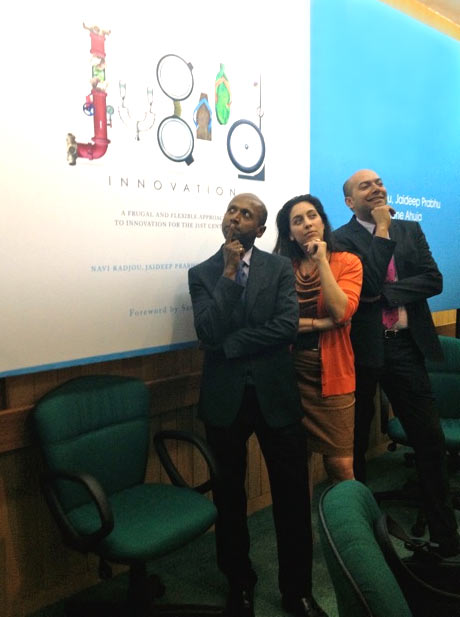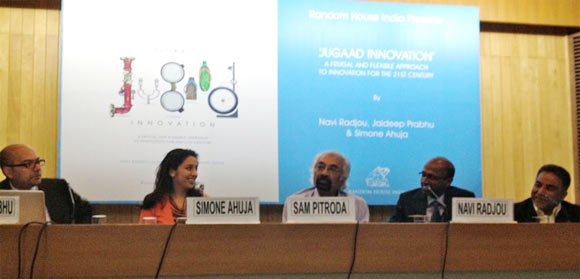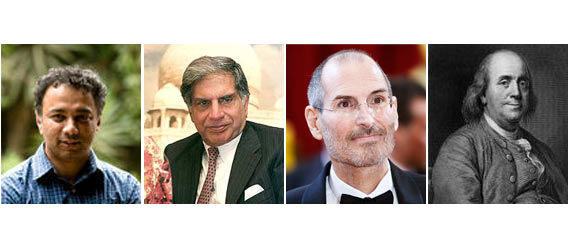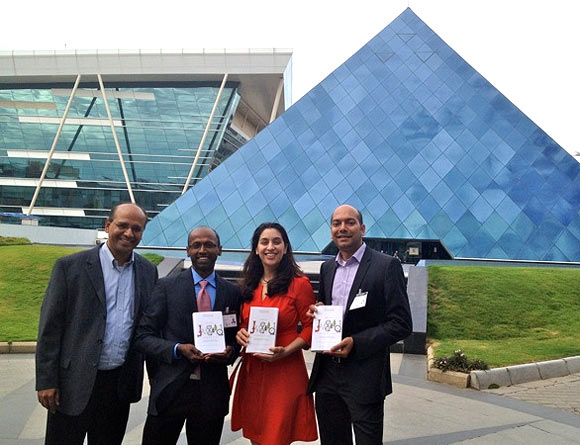
The authors of Jugaad Innovation: Think Frugal, Be Flexible, Generate Breakthrough Growth, Navi Radjou, Jaideep Prabhu and Simone Ahuja, in an intreview with rediff.com, spoke about why they think Ratan Tata makes for a great jugaad innovator, how the IITs and universities are encouraging students employ more jugaad to come up with great solutions, the jugaad innovators that inspired them and about the challenges they faced and the jugaad they used to come up with this book.
What are the six principles of Jugaad Innovation mentioned in the book?
Do you know of any jugaad innovators? Tell us about entrepreneurs who have been doing great Jugaad Innovation but are yet to be known to the outside world! Be their messengers. Spread the word about their pathbreaking innovations!

What challenges did you face while coming out with this book and what kind of jugaad did you do to overcome them?
Jaideep: Navi got an e-mail in April last year (2011) from an American literary agent who had spent three years working in India and had just gone back to US. She was looking for book titles to commission. And she wrote to Navi saying you guys have been writing about jugaad and asked if we would be interested in writing a book. We agreed and from April when we got this e-mail from her till about July we wrote a very quick proposal, got it approved from the agent and the publisher and signed a contract.
With three of us working in three different locations we improvised a lot, and that too frugally, communicated with each other through Skype and conference calls taking advantage of time differences.
In three months flat we got the proposal through, sent it to this agent who in turn sent it across different countries including Random House in India with whom we signed a contract in July and we began writing in August -- still from three different locations -- and by the end of December we had the final draft ready for submission.
Had it not been for jugaad, Jugaad Innovation would have been impossible.
So to complete writing a book in such a short time with whatever technology we had access to with quick turnaround time – we are sure people will judge it is not shoddy work -- and then not to mention what happened when we had to publish the Indian edition.
The world edition came out in March-April (2012). Random House had first decided to launch the book in India in September, but thought it would be too late after the release worldwide and decided to launch the book in June.
And we had to re-position the book for an Indian audience in two weeks, get endorsement, design a new cover, get a new foreword from Sam Pitroda, who is a very busy man, all this in two weeks. Then it went into a cycle of production and you have a high-quality, low-priced book in front of you!
What kind of value did your managing so many things in such a short time add to the final product?
Navi: The most important lesson we all learnt was we needed to learn to improvise continuously; especially in a creative field like writing or publishing. The best thing I learned was there is only so much you can plan ahead of time. Writing this very book was an embodiment of six principles of jugaad.
Simone: I think Navi nailed it. This kind of mindset of continuous jugaad applies even if you are working in different fields, in US or in India. This mindset helps you not only to survive but also survive even in adverse, volatile and quick-changing environments. I think we have all learned to do that for different reasons.
Do you know of any jugaad innovators? Tell us about entrepreneurs who have been doing great Jugaad Innovation but are yet to be known to the outside world! Be their messengers. Spread the word about their pathbreaking innovations!

How did you manage to convince Sam Pitroda to write the foreword for jugaad Innovation?
Jaideep: Actually Sam has been a big fan of jugaad for long time. I met him when he was in Silicon Valley to talk about the need for innovation in the Indian context. I approached him and requested him to write a foreword and he readily agreed. I approached him on a Thursday of a given week and by next Monday we took the draft of the foreword to Random House. That was how quick it was.
Navi was in California, Simone is in Minneapolis, I was in the UK and Sam was in all these places but somehow he pulled it off. It is a three-page foreword written from the heart. What Sam said is that India needs its own economic developmental model that is steeped in innovation that suits the Indian business environment.
We don't have to look at fancy international models but look within. We just have to take what we have and build on it through jugaad. He makes the case that imposed economic model of development will not work in India.
We couldn't have asked for a better foreword.
Jugaad is quite a familiar word in the Indian context. How did you convince your publishers and editors to have Jugaad Innovation as the title of your book for a western audience?
Simone: To convince the publishers wasn't difficult because of our experience and research with the word (jugaad) that we have done around the world. Different countries have different words to describe jugaad and we picked the one that we were most familiar with.
But frankly jugaad is getting accepted by the western audience and is becoming a part of their business lexicon. In terms of the social media a few weeks ago it was primarily an Indian audience that were tweeting about the book. But since then the focus has completely shifted and more western audience are tweeting about the book and the word jugaad.
Having said that one must also understand how we came to use the word.
We spoke to hundreds of people across India, with small entrepreneurs, CEOs of big companies, management teachers to understand what it means to them so that we could distil it down to get its true essence.
I think the western audience are more open to absorb and accept a new word if one explains the essence of the word to them.
Let me add a caveat here: three or four years ago when we first started writing about this (jugaad), the question was we don't have scarcity here (in the West), how is it relevant to us, what can we really learn from emerging markets but as the downtrend and recession deepened (from early 2009) and hopes of a quick turnaround dimmed the interest in the word jugaad as an approach to innovation that manages to do more with less began to increase.
Our book talks about jugaad that has managed to change lives of millions of people through simple innovations. In that sense, it wasn't very difficult for the word to find acceptance with a western audience.
Do you know of any jugaad innovators? Tell us about entrepreneurs who have been doing great Jugaad Innovation but are yet to be known to the outside world! Be their messengers. Spread the word about their pathbreaking innovations!

Could you give us a glimpse into the world of jugaad entrepreneurs who could become like the Tatas or the Mittals in the next ten years? Grassroots entrepreneurs who inspired you?
Navi: There are a couple of good examples. SELCO started by Harish Hande in 1995 began selling solar lamps in rural areas. Today it has installed solar energy systems in 200,000 households across rural India. And the beauty of the model is that the solution is highly personalised to the need of a particular household.
Now, the most interesting aspect of this entrepreneur is he scaled it up not in the western sense of the term but by training rural entrepreneurs who began distributing the product in rural areas. Hande made his business model more relevant to the final user wherever the household is.
Jaideep: While scale is important entrepreneurs must remember that scale should not be sought just for the sake of it. It should be in sync with the diversity of the community one is serving and should be sustainable.
Navi: The other example that comes to mind is this Bangalore-based company Embrace. The company has come up with an instant portable warmer that costs $ 200 (Rs 10,000) instead of an incubator Rs 10 lakh (Rs one million or $ 2,000).
It is essentially a baby warmer, which looks like a sleeping bag, where you can put the baby, wrap it up and the mother can hold the child in her arms. This is a fantastic way to not only keep the baby warm but also importantly maintain that emotional bonding between the mother and the child.
This is a great solution which is now being scaled up and brought to other emerging markets like China. Their product is in great demand all over the world and GE has partnered with Embrace to provide distribution support both in India and abroad.
To me this is great innovation because it is not only affordable but it also adds great value to the end-user, the mother, than a traditional incubator.
I think the co-founder of this company has the right product and right partnership to take this product globally.
The important thing is to build a standardised product and then scale it up through innovative partnerships.
Who, according to you, are the five great jugaad innovators of all times?
Navi: In the US context, I think, we can name Ben (Benjamin) Franklin, one of the founding fathers of America. He was a serial entrepreneur (much before the term was invented); he was the pioneer of the open source movement because he never patented any of his inventions!
Some of the pioneers of the industrial revolution in England also fit the bill of jugaad innovators. James Watt (steam engine), Robert Stephenson who came up with train and the first rocket and the Wright brothers are some that immediately come to mind.
I think the Victorian period threw up lots of these kinds of innovators because innovation was encouraged. The beginning of the 20th century discouraged these kinds of innovations as structured (systematic) processes began to dominate the world.
Jaideep: In recent times Apple's Steve Jobs is one example of jugaad innovator. When he came back to Apple in 1999 people advised him to sell the company and pack up but he found an opportunity in adversity (one of the principles of Jugaad Innovation) and look what Apple is doing as a company today.
On the other hand, look at a company like Sony that in 1999 had dollops of cash. They could have easily come up with a product like the iPod. They had the brand, support of distribution in Sony Music, the MP3 technology and of course the Walkman.
But Steve Jobs with his back to the wall came up with one innovative product and service (Apps) after another and gave his customers more for less (another principle followed by jugaad innovators).
Navi: In India the best example of jugaad innovator is Ratan Tata because of the flexible thinking he demonstrated by coming up with a product like the Nano. Beyond the Nano, though, look at how he scorched the automobile industry with his acquisition of the Jaguar Land Rovers.
I don't know how many people know about this but Ratan Tata gives an award to three people in the Tata Group who have actually come up with an idea that failed.
I think that is the hallmark of a great jugaad innovator: Constant experimentation. Never give up. Allow people to fail.
Jaideep: For us the spirit of jugaad is pretty much bottom-up. A lot of jugaad innovators encapsulate this principle: Take for example Mansukhbhai Prajapati (read his story here) and Harish Hande.
Simone: Actually a lot of entrepreneurs in India inspired us. That is not to say that other examples aren't inspiring. But when you see someone -- Mansukhbhai Prajapati of Mitticool is one such example -- truly facing resource constraints, don't have big R&D labs, are not formally educated, face capital constraints, and yet come up with great innovative products are always the most inspiring ones.
These kinds of entrepreneurs truly embody the spirit of Jugaad Innovation.
Do you know of any jugaad innovators? Tell us about entrepreneurs who have been doing great Jugaad Innovation but are yet to be known to the outside world! Be their messengers. Spread the word about their pathbreaking innovations!

In the making of your book you must have met a number of grassroots innovators. Did you see the Indian youth doing enough of Jugaad Innovation?
Jaideep: Absolutely. When we recently launched our book in Delhi one of the youths in the audience was a material science student. He told us about something that he had come up with in his university lab. He said he wanted to take it with 3M, had written to them but didn't get any response. Yet he wanted to take it further.
This is just one example but on the basis of our interactions with young Indians at the grassroots level we can tell you that it is the youth that is driving jugaad innovation in India, they are the ones driving the bottom-up approach.
The youth in India are empowered, idealistic and they are opting out of working with big corporates.
Navi: That is the reason that the IITs and universities in India are setting up incubation centres. These institutes are creating an environment where young Indians can innovate. The idea is to say it's great that you come here to study but then if you come up with a cool idea just don't wait!
Your advice to India's jugaad innovators...
Jaideep: I don't know if I can advice but may the jugaad force be with you.
Simone: Don't ever let a good idea die. Don't just let go because of resource constraints. Innovate and find simple ways out of a situation.
Look within, like Sam Pitroda says in the book's foreword. Embrace your strengths and may the jugaad force be with you.
Navi: I think jugaad entrepreneurs should never let lose sight of principle number six of Jugaad Innovation: Follow your heart. I think that is the best piece of advice for India's young innovators.
Do you know of any jugaad innovators? Tell us about entrepreneurs who have been doing great Jugaad Innovation but are yet to be known to the outside world! Be their messengers. Spread the word about their pathbreaking innovations!